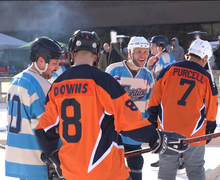Symir Torrence’s emergence as a role player means his waiting is over
Elizabeth Billman | Senior Staff Photographer
Symir Torrence has been crucial in the sixth man role and has been one of the best passers on the Orange.
Get the latest Syracuse news delivered right to your inbox.
Subscribe to our sports newsletter here.
Jake Presutti’s office had served as a quasi-film room for Symir Torrence throughout last season. The two sat in opposite corners — Marquette’s assistant coach in one, its reserve guard in the other — as Presutti pulled up clips of Torrence’s minutes onto a television. The minutes were limited at times, but they had a sample to work with.
Meetings like these became regular occurrences as Torrence was assigned to Presutti’s “player group” at the start of the season. They broke down Torrence’s offensive spacing and his ball-screen coverage on defense. Torrence didn’t always try to have an answer or anticipate what Presutti would say when pointing out the lapses, and “that was a breath of fresh air” for Presutti.
But by mid-March, the topic of those conversations shifted. Marquette had stumbled to a 13-14 record. Torrence started the first three games, but he came off the bench for the final 21. Steve Wojciechowski, the coach that recruited Torrence to the school, had been fired. Presutti was still on the staff as Marquette transitioned to the Shaka Smart tenure, and he listened as Torrence decided on his potential plans for the following season — staying at Marquette, entering the transfer portal or, eventually, returning back to his hometown of Syracuse.
Waiting, or biding time, had been a constant throughout Torrence’s basketball trajectory. He served as the City Rocks AAU team’s sixth man for two years before sliding into its starting lineup three games into his 17U season. He became Alex Popp’s starting point guard at Vermont Academy after a year of waiting for the incumbent players to graduate. At Marquette, he hadn’t been able to crawl ahead on the depth chart after Markus Howard graduated, and Syracuse served as an opportunity for another chance to potentially become a starter at the collegiate level.
“I got the sense that in the back of his mind he kind of wanted to be close to his home and playing for Syracuse,” said Steve Dagostino, Torrence’s trainer from the last two offseasons. “So I think it was like a relief for him that he was going to have that opportunity.”
His first year with the Orange has fluctuated between a necessary role player — for handling the press and relieving starting guard Joe Girard III when he struggles to run the offense — and a more limited one due to injury or when Girard is producing offensively. Torrence suffered a head injury against Duke on Feb. 26, but his father, Craig Davis, told The Daily Orange that he expects Torrence to play in the ACC Tournament — barring any setbacks before opening tip on Wednesday. And how far Torrence is able to help SU maneuver through the conference tournament’s bracket will set the foundation for his offseason, when head coach Jim Boeheim said he needs to refine his jump shot or, according to those close to Torrence, carve out enough of a role where the shooting numbers he produced in high school can materialize again.
“He doesn’t have a problem with sometimes taking a backseat, waiting for his opportunity to come,” Davis said. “Because he knows it will eventually come.”
Before he announced his commitment to Syracuse on March 31, 2021, Torrence started driving up to Albany a couple of times each week — just like he did the previous offseason, when COVID-19 shut down gyms — to Dagostino’s gyms. Dagostino, who also trained former SU star Elijah Hughes as he prepped for the NBA draft, helped Torrence hone his shooting stroke and finishing around the rim with an emphasis on replicating live-game situations.
Dagostino would make Torrence shoot with a hand in his face every time some days. On others, they’d do a mental shooting drill where he’d start at half-court, sprint to the 3-point line before catching and shooting. If the ball went in, it counted as plus-one. If it missed, it was minus-three. And they kept going — half-court, 3-point line, catch, shoot — until Torrence reached plus-10 in seven minutes.
They also worked on continuing to sharpen what Popp called Torrence’s “unorthodox” shooting form, one where his feet aren’t always fluid. City Rocks coach Jim Hart called it a “two-step shot” instead of one smooth motion. But none of the coaches Torrence worked with decided to strip it down because he hit shots with a consistent stroke. “The most repeatable swing is the best one,” Hart said.

Symir Torrence has always filled that sixth man role. Courtesy of Craig Davis
At Vermont Academy, Torrence still emerged as its focal point offensively, kickstarting the offense in transition, on pick-and-rolls or even in the post to set up kick-out passes. Popp called for double ball-screens, flat ball-screens, twist screens, dribble-handoffs — anything to free up Torrence.
“You name it, we tried to get him as many different looks as possible,” Popp said.
Torrence averaged 17.1 and 19.4 points per game his two seasons at the school after transferring from Syracuse Academy of Science, transitioning into their full-time point guard role his second season. Torrence, who had first emerged on Popp’s radar through the City Rocks program, did “form shooting until our arm falls off or we die of boredom,” Popp said, and sharpened his man defense. That turned him into another rim protector who could rotate over and take charges. Torrence learned to dissect pick-and-roll coverages while conducting them for Vermont Academy at the other end of the floor.
But it took time for all of that to result in significant playing time at Marquette. Then came his transfer to Syracuse, where he continued to wait behind Girard, and he became someone who could push the ball up the court and make the extra passes to set up top scorers Buddy Boeheim and Cole Swider instead of being that focal point himself. Three dribbles toward the paint and a kick-out becomes a go-to move, Hart said.
“He’s struggling to score. He’s shooting it poorly from the free-throw line, from the field, from the 3,” Boeheim said on Jan. 17. Instead, Torrence added to SU’s offense in different ways, and “he’s what you look for in a point guard,” said Travis Evee, a Vermont Academy teammate.

Maya Goosmann | Digital Design Director
With Syracuse trailing Duke 16-6 early in the first half, Torrence created an isolated scenario for himself on Joey Baker. He motioned to Jesse Edwards, then sized up Baker at the same time as he slid from the right block to the left.
Edwards did as instructed, and Torrence drove. He took two powerful steps to his right, gaining space on Baker, but then paused right before reaching the block and banked a floater through the net.
He and Dagostino worked on that move over the summer, called a “wide finish” — it wouldn’t always be possible, especially as a guard, to finish his shots from the blocks. It served as the latest reminder of Torrence’s skillset flashing in the limited minutes, and the waiting he’d endured through his first year with a new program. And if everything unfolds over the next offseason, the rest of his skillset that defined his rise as a prospect will start to slowly resurface again, too.
“It’s the same thing he did when he was out at Marquette, when he played behind Markus Howard: he just waited on the moment,” Davis said. “The moment comes, you got to be ready to go.”
“Just stay ready.”
Published on March 9, 2022 at 12:25 am
Contact Andrew: arcrane@syr.edu | @CraneAndrew





